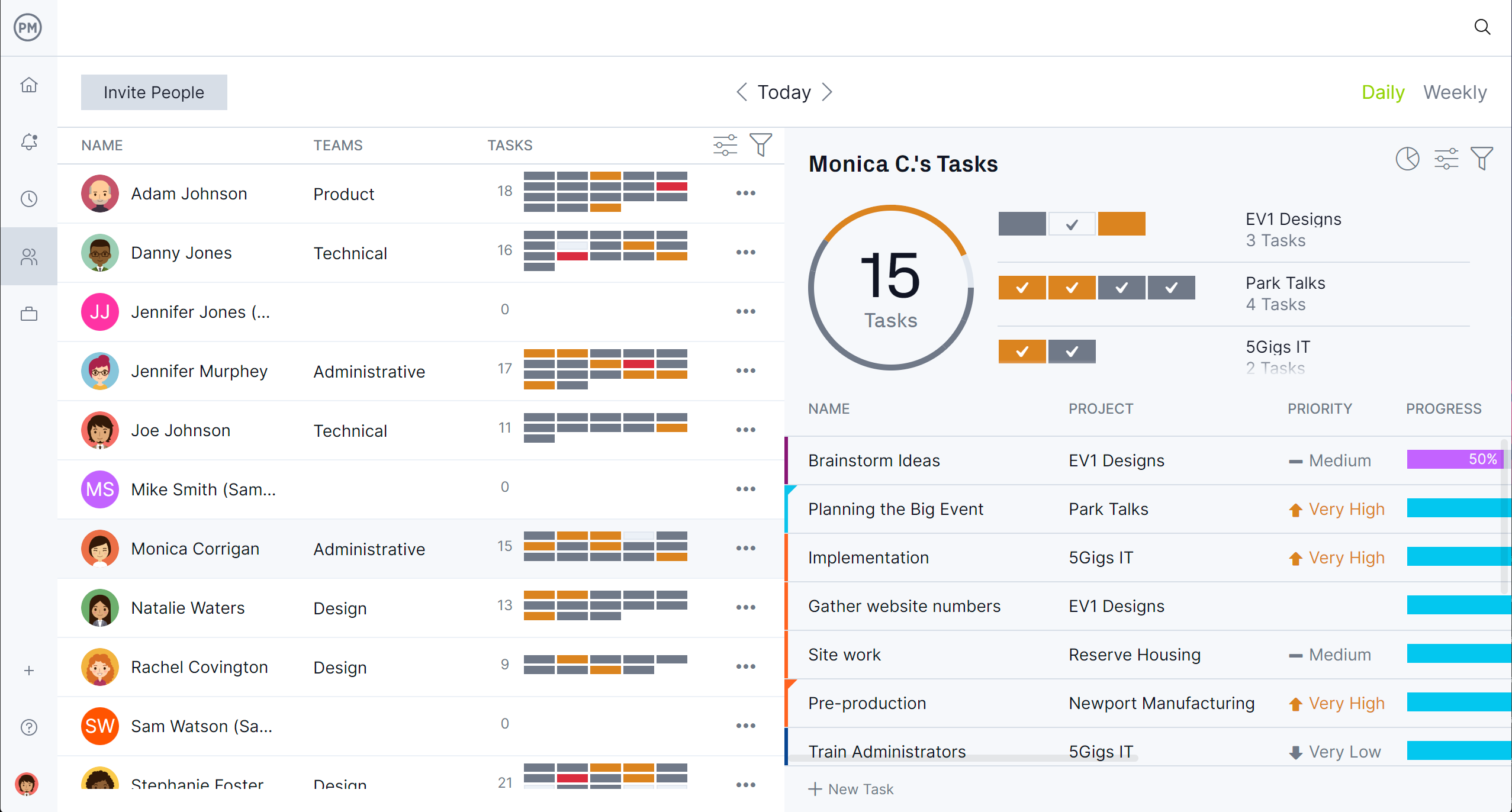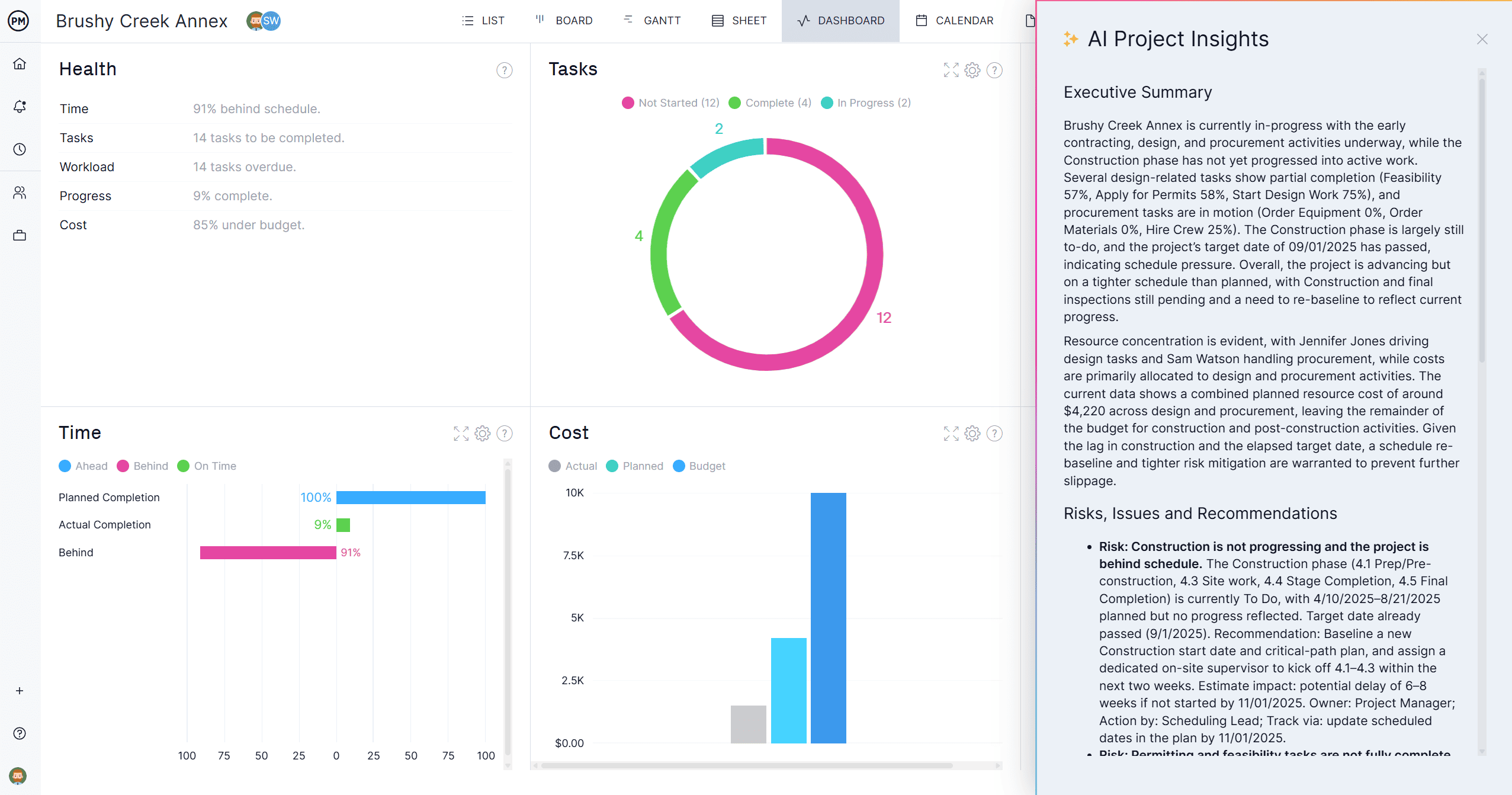Construction resource scheduling is essential for coordinating materials, labor and equipment efficiently across multiple job sites. The process ensures that the right resources are available when needed, preventing delays and budget overruns. Successful construction resource scheduling helps maintain timelines, optimize productivity and reduce waste, which is vital in an industry where every hour and cost counts. Modern tools simplify this process, allowing managers to plan, allocate and track resources effectively throughout each phase of the project.
What Is Construction Resource Scheduling?
Construction resource scheduling is the process of allocating and managing project resources—such as labor, equipment and materials—throughout the construction lifecycle. It ensures tasks are completed in the right sequence with optimal resource use to meet project deadlines and budgets. Effective scheduling helps avoid resource shortages, overlaps and downtime that can disrupt progress and inflate costs.
Construction project management software is ideal for this process because it provides centralized tools to schedule resources, assign tasks and monitor availability in real time. These platforms integrate timelines, workloads and costs, allowing teams to identify bottlenecks and balance resources across concurrent projects seamlessly.
ProjectManager stands out as the best choice for construction resource scheduling. It features dynamic workload charts, Gantt-based scheduling, real-time dashboards and mobile timesheets that keep teams coordinated. With the ability to track labor costs, equipment usage and material allocation, our software empowers construction professionals to manage complex projects efficiently from planning to delivery. Get started with ProjectManager today for free.
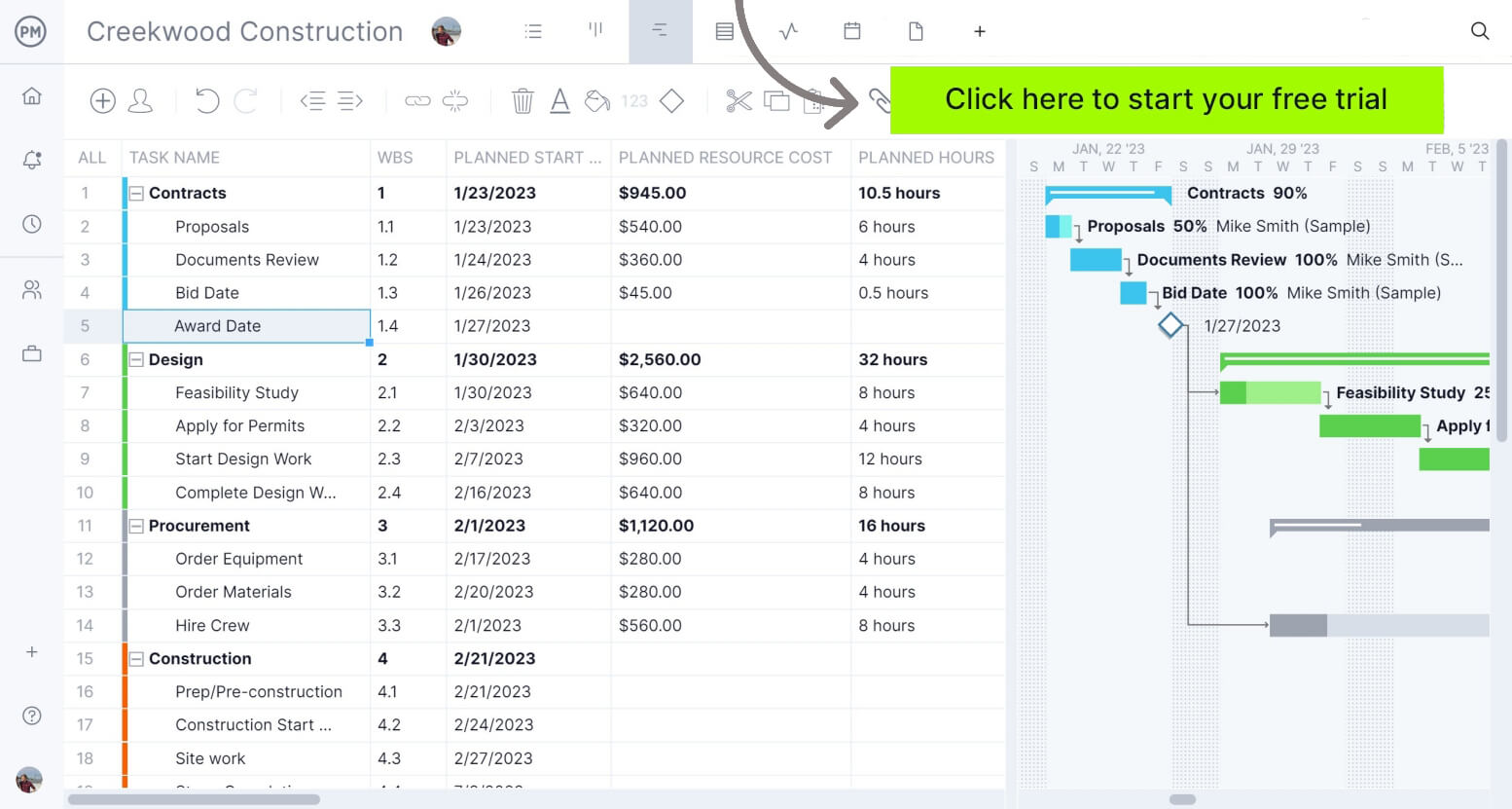

What Is a Construction Resource Schedule?
A construction schedule focuses on the timeline of tasks and milestones, showing when specific work should occur. A construction resource schedule, however, details which resources—such as labor, materials and equipment—are needed for each task. While the construction schedule tracks time, the construction resource schedule ensures that the right resources are available to execute the plan efficiently.
What Types of Resources Are Considered in Construction Resource Scheduling?
Construction resource scheduling accounts for all essential project inputs. These include the workforce performing the work, equipment used on-site and materials required for each phase. Properly managing these resources ensures smooth operations, prevents shortages and keeps project budgets under control.
- Manual labor: Refers to direct-hire workers employed by the general contractor, including site laborers, carpenters, masons, electricians, plumbers and supervisors. Their work hours are directly managed and allocated to specific tasks within the project schedule.
- Subcontractor crews: Specialized external teams hired under contract to perform specific trades—such as electrical, plumbing, HVAC, or roofing—whose labor and equipment are indirectly controlled by the general contractor and must be carefully coordinated in the resource schedule to prevent overlaps with other trades.
- Heavy machinery: Refers to large, shared assets like excavators, cranes, bulldozers and loaders that must be scheduled carefully to prevent conflicts or idle time.
- Raw materials: Covers bulk items such as concrete, steel, lumber, aggregates and asphalt that need to arrive on site in sync with the construction sequence.
- Construction equipment: Smaller reusable assets such as generators, compressors, scaffolding and formwork systems that support daily operations.
- Tools, consumables and safety equipment: Includes hand tools, drills, cutting devices, PPE, fuel and other expendables that are needed continuously and must be replenished.
Construction Resource Scheduling Process
The construction resource scheduling process ensures that all labor, equipment and materials are available when needed to meet project deadlines. It involves defining project requirements, organizing resources and aligning them with the schedule to avoid conflicts or shortages that can disrupt workflow and increase costs.
1. Define the Scope of Work for a Construction Project
The first step in construction resource scheduling is outlining the full scope of work. This includes defining project objectives, deliverables and constraints. A clear scope ensures that every phase of the project is accounted for and helps determine what types of resources are needed to complete each activity efficiently and on time.
Related: Free Construction Scope of Work Template
2. Perform a Material Takeoff and Prepare a Bill of Quantities
Once the scope is defined, teams perform a material takeoff to list and quantify all required construction materials. This information is then organized into a bill of quantities. This document forms the foundation for budgeting, procurement and tracking material usage throughout the construction resource scheduling process.
3. Make a Resource Breakdown Structure
A resource breakdown structure categorizes all resources into logical groups, such as labor, equipment and materials. It helps organize the data needed for estimating and scheduling. By breaking down resources this way, project managers can easily allocate responsibilities and monitor resource usage throughout the construction lifecycle.
4. Estimate Resource Quantities, Crew Sizes and Usage Rates
Estimating the quantities of materials, required crew sizes and resource usage rates ensures realistic planning. Construction resource scheduling depends on accurate estimations to prevent overuse or idle time. This step helps balance workload distribution and ensures that the schedule aligns with productivity rates and resource availability.
Related: 10 Free Construction Expense Tracker Templates
5. Allocate Resources for Each Project Task
After estimating needs, project managers allocate resources to specific project tasks. This includes assigning labor to activities, scheduling equipment use and confirming material delivery dates. Proper allocation prevents resource conflicts and ensures that every aspect of the project is supported by the necessary tools, personnel and materials.


6. Create a Construction Schedule
The construction schedule maps out all tasks and their durations, dependencies and milestones. It establishes the project timeline and provides a visual guide for sequencing work. Once this schedule is developed, it becomes the framework upon which the construction resource schedule is built and refined.
7. Make a Resource Schedule that Aligns with the Overall Project Timeline
The final step is creating a resource schedule that aligns with the construction timeline. This schedule matches resource availability with project tasks, ensuring smooth coordination. Construction resource scheduling software helps automate this step, optimizing resource usage while keeping the project on time and within budget.
Construction Resource Scheduling Tools
Construction resource scheduling tools help project managers plan, allocate and track resources across complex projects. These tools visualize workloads, identify constraints and optimize resource use. By leveraging them, construction teams can coordinate labor, equipment and materials more effectively to maintain productivity and stay on schedule.
Resource Breakdown Structure (RBS)
A resource breakdown structure (RBS) is a hierarchical chart that categorizes all project resources, including labor, materials and equipment. It outlines what resources are required and how they’re organized. In construction resource scheduling, the RBS ensures that every resource type is accounted for and properly allocated.
Resource Histogram
A resource histogram is a visual graph that displays resource usage over time. It shows how labor or equipment demand fluctuates throughout a project. For construction resource scheduling, histograms help identify overallocations or idle periods, allowing managers to adjust workloads to maintain efficiency and avoid project delays.
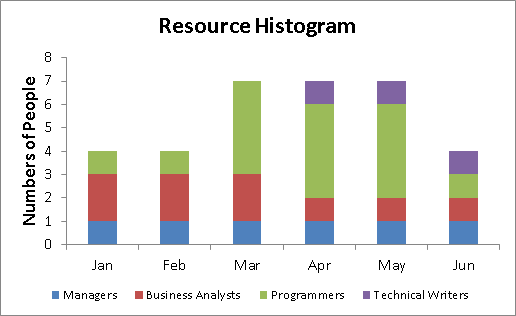

Gantt Chart
A Gantt chart is a scheduling tool that outlines project tasks along a timeline, showing their durations, dependencies and start or finish dates. In construction resource scheduling, it helps align resource availability with project milestones, ensuring that labor and equipment are deployed efficiently to meet key deadlines.
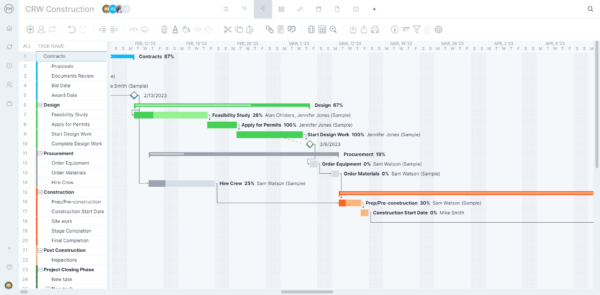

Resource Allocation Matrix
A resource allocation matrix maps specific resources to tasks or work packages within a project. It clarifies responsibilities and prevents conflicts over resource use. In construction resource scheduling, this matrix ensures that every task has the required materials, crew and equipment assigned for timely completion.
Resource Utilization Reports
Resource utilization reports track how effectively resources are used across a project. These reports measure actual usage versus planned allocation, identifying inefficiencies or bottlenecks. For construction resource scheduling, they provide data-driven insights that help managers optimize resource distribution and improve overall project performance.
Related: 20 Best Resource Management Software of 2025 (Free & Paid)
Construction Resource Scheduling Techniques
Construction resource scheduling techniques help project managers balance time, cost and resource constraints while maintaining productivity. These methods optimize how labor, materials and equipment are used throughout the project lifecycle. By applying them, construction teams can meet deadlines, reduce waste and improve overall scheduling accuracy.
Critical Path Method (CPM)
The critical path method (CPM) identifies the longest sequence of dependent tasks that determines a project’s duration. It highlights activities that directly affect completion time. In construction resource scheduling, CPM helps allocate key resources to critical tasks, ensuring project milestones are met without unnecessary delays or cost overruns.
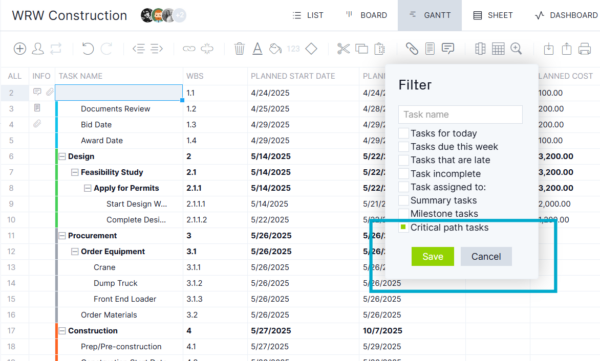

Resource Leveling
Resource leveling is a technique that adjusts task start and end dates based on resource availability. It ensures no team member, material or equipment is overallocated. In construction resource scheduling, resource leveling balances workloads, reduces idle time and prevents burnout, supporting a more consistent and realistic project timeline.
Resource Smoothing
Resource smoothing maintains a project’s timeline while adjusting resource allocation to avoid peaks and valleys in workload. It focuses on optimizing efficiency without extending deadlines. For construction resource scheduling, resource smoothing ensures steady productivity and balanced resource use, minimizing disruptions while keeping the project’s critical path intact.
Fast Tracking
Fast tracking involves performing tasks in parallel rather than sequentially to compress the project schedule. It reduces total duration but can increase coordination risks. In construction resource scheduling, fast tracking enables overlapping activities like design and procurement, helping teams accelerate delivery while efficiently using available resources.
Project Crashing
Project crashing shortens the schedule by adding extra resources or increasing effort on critical tasks. It often raises costs but reduces completion time. In construction resource scheduling, crashing helps meet urgent deadlines by deploying additional labor or equipment strategically to maintain project quality and control time-sensitive deliverables.
Free Construction Resource Scheduling Templates
Construction resource scheduling templates streamline project planning by providing ready-made frameworks for organizing tasks, resources and timelines. These free templates save time, reduce errors and make it easier to track labor, equipment and material usage across multiple projects. Using templates ensures consistency while supporting accurate resource allocation and reporting.
Construction Schedule Template
Download this free construction schedule template to allow project managers to assign resources, set deadlines and track progress visually. This template is ideal for managing complex projects, helping teams align activities with overall project goals and ensuring resources are available when needed.
Resource Plan Template
Use this free resource plan template to list all personnel, equipment and materials required for a project. It helps project managers allocate resources efficiently, monitor availability and avoid overallocation. By visualizing resource demands, the template supports better construction resource scheduling, ensuring each task has the right resources at the right time.
Workload Analysis Template
This workload analysis template monitors team and equipment utilization over the project timeline. It highlights underused or overburdened resources, allowing managers to rebalance tasks and optimize productivity. Using this template improves construction resource scheduling by maintaining a steady workflow and preventing bottlenecks throughout the project.
ProjectManager Is Award-Winning Construction Resource Scheduling Software
ProjectManager provides construction teams with multiple project views, including Gantt charts, kanban boards, task lists and calendar layouts. These views make it easy to visualize project timelines, dependencies and milestones in one place. By offering a flexible interface, our software ensures construction resource scheduling is intuitive, allowing managers to plan, adjust and track projects without switching between applications or losing critical information.
Optimize Resource Management Across Teams
ProjectManager streamlines construction resource scheduling by enabling managers to plan and balance workloads using the team page and visual workload charts. Teams can see their assigned tasks, availability and upcoming deadlines, while managers can identify bottlenecks or overallocated personnel. This feature ensures optimal use of labor, equipment and materials, helping projects stay on schedule and resources are used efficiently throughout the construction lifecycle.
Track Progress With Real-Time Dashboards and Reports
ProjectManager enhances construction resource scheduling by providing AI-powered dashboards, customizable reports and secure timesheets that can be updated from the job site with mobile apps. These all help with tracking labor costs and project performance. Managers can monitor progress, identify risks and adjust resources as needed. These tools give construction teams the insight they need to make data-driven decisions, keeping projects on time, within budget and aligned with overall goals.
Related Construction Scheduling Content
There’s more to construction resource scheduling than we’ve touched on here. For readers who care to expand the lens, check out the links below. There are articles exploring the critical path method, material schedules and more.
ProjectManager is online project and portfolio management software that connects teams, whether they’re in the office or out in the field. Teams can share files, comment at the task level and stay updated with email and in-app notifications. Get started with ProjectManager today for free.




